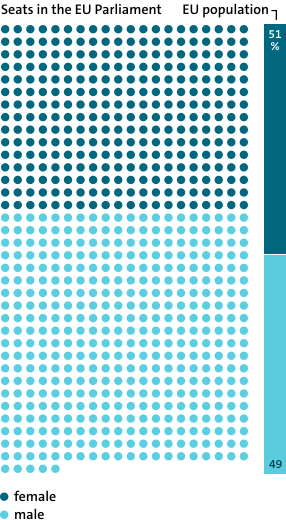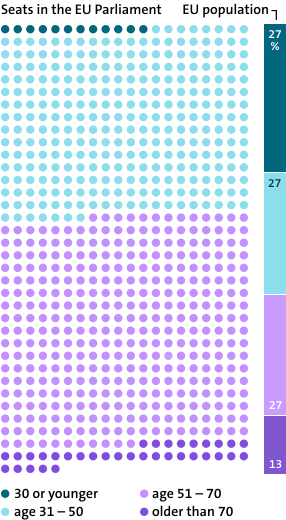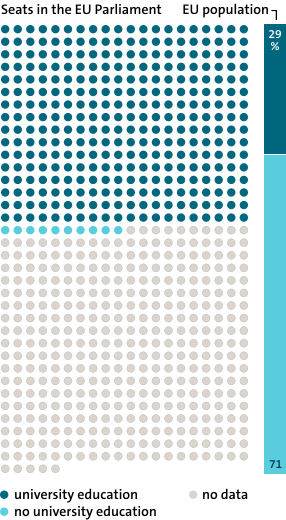Male, over 50, with a doctorate: this is the European Parliament today
On 9 June, Europeans will be voting to elect their next European Parliament. Data analysis by SWR Data Lab shows that the European Parliament is not as diverse as it could be.

©Artens/Shutterstock
Around 450 million people, 24 languages, one parliament: the EU is diverse in more than just culture and language. Its citizens differ in sex, age, educational level and many other characteristics. Data analysis carried out by SWR Data Lab and its partners in the European Data Journalism Network (EDJNet) reveals the composition of the outgoing European Parliament.

The European Parliament
In the current legislative period, the EU Parliament has 705 members representing the nearly 450 million citizens of the EU. Each dot in this graphic represents one seat in the parliament.
Women in the EU Parliament
There are significantly fewer women than men in the European Parliament. Yet more than half the EU population (roughly 51%) is female.
More male MEPs
There are 280 women in the European Parliament, as against 425 men. If the number of female MEPs were in proportion to the number of women in the population, they would occupy just over half the seats.
Fewer women than in the EU population, but more than in the Bundestag
Four out of ten MEPs are women. While this does not correspond to the proportion of women in the EU population, it has increased significantly since the first EU Parliament in 1979, when fewer than two in ten seats in the plenary chamber were held by women. The German Bundestag and the state parliaments of Baden Württemberg and Rhineland-Palatinate also lag behind the EU Parliament in this respect: none of them has more than around three in ten female elected members.
SWR Data Lab has analysed European Parliament data on the gender of its parliamentarians. When Members take up their office, they are asked to state their gender, choosing from four options: male, female, other, or prefer not to say. All 705 individuals in the analysed data identified as either male or female.
Luxembourg has the highest proportion of female MEPs
Each Member State has a guaranteed number of seats in the Parliament. Its citizens elect their MEPs by voting for a party. The SWR data analysis shows that the gender distribution of MEPs varies greatly from country to country.
Fewer women in right-wing political groups
There are pronounced differences between the political groups, depending on their political orientation: left-wing groups have a higher proportion of women than groups that are right of centre.
Committees are assigned along traditional lines
MEPs spend most of their time in committees, however, not in the plenary chamber. There are 22 committees in total, where they negotiate important details such as exhaust emission values, data protection rules and agricultural subsidies.
Here, too, the proportion of men and women varies depending on the committee. The following chart shows the four committees with the highest and lowest proportions of women.
MEPs are older than the population as a whole
The median age of the 705 MEPs is 54 – meaning that if they were all to line up in order of age, the 54-year-olds would be right in the middle.
This makes the Members of the European Parliament significantly older than the EU population as a whole. And the EU population is itself one of the oldest when compared internationally, with a median age of 44.5, as against 39 in the USA.

Few young MEPs
Depending on the Member State, candidates for the European Parliament must be at least 18, 21, 23 or 25 years old. The youngest MEP in the current legislative period is Kira Marie Peter-Hansen from Denmark, who was just 21 when she entered Parliament. Overall, young people are poorly represented in the EU Parliament: there are just 12 MEPs aged 30 or younger.
Most MEPs are aged between 30 and 70, with the over-50s conspicuously over-represented.
13% of the EU population is aged over 70. The oldest MEP is currently Jerzy Buzek, from Poland. He has been a member of the European Parliament since 2004, and was 78 at the time of his re-election in 2019.
There are also big differences between the EU Member States in terms of the ages of their MEPs. The following graphic shows the extent to which the ages of countries’ MEPs differ from those of their populations.
The situation is particularly extreme in the case of Cyprus: the median age of its six MEPs is nearly 22 years higher than that of its population. Malta has the smallest difference, with less than two years between the median ages of its MEPs and its population.
The Green group has the youngest MEPs
The ages of a Member State’s MEPs are linked with the results gained by its various parties in the election. The analysis shows that right-of-centre MEPs tend to be older than those in left-wing groups. The Green group is the youngest, with a median age of 48; the Conservative group the oldest, at 58.
A preponderance of academics
MEPs differ in terms of their career backgrounds as well as their ages, as can be seen from the CVs that many of them put on the Parliament website. This information is provided voluntarily and may be incomplete, so SWR Data Lab combined it with information from Wikidata, which enabled it to analyse the data for 330 of the 705 MEPs.

Education systems and access to education vary greatly across the EU. In 2023, 29.4% of 15-to-74 year-olds in the EU had a university degree or comparable qualification.
Of the 330 MEPs for whom data is available, 97% studied at university level.
This means that almost all the MEPs whose data has been analysed have an academic background. Just 3% have no university education.
MEPs’ high educational level is also reflected in the number of doctorates they hold: 105 of the 330 MEPs whose CVs were analysed had a doctorate. This equates to nearly 15% of the 705 MEPs. By contrast, just over 1% of the population of Germany had a doctorate in 2019.
Scientists dominate the Parliament
The CVs and Wikidata also give details of MEPs’ professional backgrounds. SWR Data Lab used these to define a number of broad occupational categories in order to give an overview of their careers before and during their time as MEPs. The following chart shows the most frequently stated occupational fields.
Little data on other diversity criteria
It is difficult to compare MEPs with the EU population in areas such as religious identity, sexual orientation, ethnicity and whether they are living with a disability, since this kind of data does not always exist, either for MEPs or the population as a whole.
Many Member States do not collect data on ethnic identity, says Tina Magazzini, part of a research team that was commissioned by the European Network Against Racism to analyse the diversity of the European Parliament. According to the survey carried out by her team, 4.3% of MEPs identify as non-white. The team estimates that the equivalent figure among the population is at least 10%, but there are no precise figures, either for the Parliament or for the population.
This is also the case in Germany. In reply to SWR Data Lab, a spokesperson for the Federal Anti-Discrimination Agency stressed that they are in favour of including ethnicity and sexual orientation in major recurring surveys such as the Socio-Economic Panel, since this would make it possible to record structural disadvantage. Replies to these questions would have to be optional, however, and on the basis of self-reporting.
Does a parliament need to be a reflection of the population?
It is clear from the data that Members of the European Parliament are not fully representative of the EU population in terms of gender, age, education or professional background. And according to Gabriele Abels, Professor of Comparative Politics and European Integration at the University of Tübingen, democratic theory does not require them to be: the 2005 Statute for Members of the European Parliament states that MEPs are not “intended to be representatives of group interests”.
She adds, however, that “There are examples showing that having a higher proportion of women in parliament has a positive effect on certain issues. Areas of social policy such as childcare, violence against women or wage discrimination, for instance, are raised more strongly.”
This latest parliament, especially, has passed a large number of measures in the field of equality and anti-discrimination, she says. “The feeling of being affected differs between the genders in relation to many issues. And being affected is an important driver for political activism.” As for the composition of the next European Parliament, that will be decided by citizens in the upcoming European election.
Original source: https://www.swr.de/swraktuell/eu-parlament-nicht-so-divers-wie-eu-buerger-100.html
